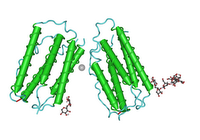Cytokines are small proteins that regulate and mediate
immunity,
inflammation, and
hematopoiesis. They are secreted
de novo in response to immune
stimuli, and usually act briefly, locally, at very low concentrations (the exception being endocrine action at distant cells). All cytokines possess four
conserved cysteine residues, and are divided into two
families based upon the
contiguity (
CC) or
separation of cysteine residues (
CXC).
The orchestration and regulation of cytokine production during
inflammatory responses constitutes a key determinant of both the resolution of challenge and the limitation of host tissue damage. Cytokines bind to specific membrane
receptors, which then signal the cell via
second messengers, often
tyrosine kinases, to alter cellular activity (
gene expression). Cytokines are often produced in
cascades.
Tables
Immune Cytokines
Fc receptors
Immunoglobulins
Interferons▼
actions :
chemokine :
chemokine family receptors :
classification of cytokines :
colony-stimulating factors (
CSF) :
cytokine cascade :
cytokine effects :
cytokine receptors :
cytokine secreting cells :
distance of cytokine action :
granulocyte colony-stimulating factor (
G-CSF) :
granulocyte-macrophage colony-stimulating factor (
GM-CSF) :
hematopoietin family receptors :
interleukins,
interleukins as largest group :
interferon family receptors (
IFNR) :
largest group of cytokines :
lymphokine :
lymphotoxins :
macrophage colony-stimulating factor (
M-CSF) :
mechanism of cytokine action :
monokine :
receptors :
search for novel cytokines :
target cells :
tumor necrosis family receptors(
TNFR) ▼
Actions of cytokines include:
a) up- or down-regulation of the
expression of
membrane proteins (including
cytokine receptors),
b) secretion of
effector molecules: histamine release;
antibody secretion -
IgA, IgG1, and
IgE synthesis;
IL-1 synthesis;
cytokine production;
MHC Class II; and
CAM expression
c) cellular
proliferationd)
chemotaxis of
neutrophils,
monocytes, and
T cellse)
cellular differentiationf)
inflammationg)
phagocytosish)
death of
tumor cellsi) elimination of
pathogensCytokines are
classified according to the
cells that produce them:
a)
Lymphokines - produced by
lymphocytesb)
Monokines - produced by
monocytes,
c)
Chemokines -
chemotactic activities
d)
Interleukins - manufactured by one
leukocyte to act on
other leukocytes.
The cells that
produce cytokines include
B cells,
T cells,
dendritic cells,
NK,
Tc,
Th,
Th1,
Th2, endothelial cells,
mast cells,
plasma cells,
progenitor,
marrow stroma,
thymus stroma, and
tumor cells, along with fibroblasts,
leukocytes,
monocytes, and
macrophages.
Cytokine function may be
targetted at:
a) The cells that secrete them (
autocrine action),
b) Local cells (
paracrine action),
c) Distant cells (
endocrine action).
Target cells include:
B cells,
T cells,
NK,
Tc,
Th,
Th2,
stem,
mast cells,
plasma cells,
progenitor,
tumor cells,
phagocytes,
neutrophils,
monocytes, and
macrophages.
Macrophage migration inhibitory factor (
MIF) is an inflammatory cytokine secreted by several cell types, including mononuclear cells of the immune system and pituitary cells in the brain. Functional
promoter polymorphisms in the MIF gene affect the clinical presentation of systemic sclerosis (SSc, scleroderma) and confer susceptibility to systemic lupus erythematosis (SLE). MIF counteracts cortisol-induced inhibition of inflammatory cytokine secretion, and employs the
CD74 receptor.
Cytokines bind to specific
membrane receptors:
a)
Hematopoietin family receptors - dimers or trimers with conserved
cysteines in their extracellular domains and a
conserved Trp-
Ser-X-
Trp-
Ser sequence.
The two subunits are i) cytokine-specific, and ii)
signal transducing.
Cytokine binding promotes dimerization of the alpha and beta subunits, which then associate with
cytoplasmic tyrosine kinases to
phosphorylate proteins and activate
mRNA transcription. Examples - receptors for
IL-2 through
IL-7 and
GM-CSF.
Colony-stimulating factors (CSFs) are glycoprotein molecules that support growth of
hematopoietic colonies. Interleukin 3 (
IL-3) exhibits broad activity in the proliferation and differentiation of
erythroid,
megakaryocytic, and
myeloid lineage
progenitor cells.
Macrophage colony-stimulating factor (
M-CSF, CSF1) acts selectively on the
macrophage lineage, while
granulocyte colony-stimulating factor (
G-CSF) acts selectively on cells of the
granulocyte lineage.
Granulocyte colony-stimulating factor (
G-CSF) and
granulocyte-macrophage colony-stimulating factor (
GM-CSF) have
pleiotropic activating effects on mature
leukocytes, which can improve leukocyte function, facilitating eradication of microbial infections.
G-CSF activates
neutrophils, while
GM-CSF activates
neutrophils,
eosinophils, and
monocyte/
macrophages.
G-CSF is a 19.6 kDA glycoprotein that exists in two forms, comprising either 174 or 180 amino-acids. It is produced in a number of different tissues and stimulates
granulopoietic proliferation and
differentiation in the
bone marrow.
GM-CSF is a 14.6 kDa globular protein of 128 amino acids that contains two intramolecular disulfide bonds and two potential N-linked glycosylation sites. It is produced by endothelial cells, monocytes, fibroblasts and T-lymphocytes. GM-CSF is a hematopoietic growth factor that stimulates the development of macrophages and neutrophils, and inhibits neutrophil migration while enhancing the functional activity of the mature end-cells. It also promotes the proliferation and development of early erythroid megakaryocytic and eosinophilic progenitor cells.
b)
Interferon (
IFN)
family receptors have the conserved cysteine residues but
not the Trp-Ser-X-Trp-Ser sequence, and include the receptors for
IFNα,
IFNb, and
IFNγ.
c)
Tumor Necrosis Factor family receptors possess four extracellular domains, and include receptors for soluble
TNFα and
TNFβ as well as membrane-bound
CD40 (important for
B cell activation and
macrophage activation) and
Fas (which signals the cell to undergo
apoptosis).
TNFα is
lymphotoxin β (LT), where the lymphotoxins occur either as homotrimers of LT-α (LT-α3) or as heterotrimers of one LT-α subunit plus two LT-β subunits (LT-α,β2).[
s]
d)
Chemokine family receptors have seven transmembrane helices and interact with
G protein. This family includes receptors for
IL-8,
MIP-1 and
RANTES. Chemokine receptors
CCR5 and
CXCR4 are used by
HIV to preferentially enter either
macrophages or
T cells.
Cytokines are often produced in
cascades, as one cytokine stimulates its target cells to produce additional cytokines. Cytokines are
redundant in their activity, in that different cytokines can stimulated similar functions. Different cell types may secrete the same cytokine, or for a single cytokine may act on several different cell types (
pleiotropy). Cytokines can also act
synergistically with two or more cytokines acting together, or
antagonistically with cytokines causing opposing activities.
Interleukins comprise the
largest group of cytokines, stimulating
proliferation and
differentiation of
immune cells. The group includes
Interleukin 1 (
IL-1), which
activates T cells;
IL-2, which stimulates
proliferation of antigen-
activated T and
B cells;
IL-4,
IL-5, and
IL-6, which stimulate
proliferation and
differentiation of
B cells;
Interferon gamma (
IFNγ), which activates
macrophages; and
IL-3,
IL-7 and Granulocyte Monocyte Colony-Stimulating Factor (
GM-CSF), which stimulate
hematopoiesis.
Short half lives, low plasma concentrations,
pleiotropy, and redundancy combine to make the isolation and characterization of cytokines difficult. Search for novel cytokines is often conducted at the DNA level, identifying genes that are similar to known cytokine genes.
▲
actions :
chemokine :
chemokine family receptors :
classification of cytokines :
colony-stimulating factors (
CSF) :
cytokine cascade :
cytokine effects :
cytokine receptors :
cytokine secreting cells :
distance of cytokine action :
granulocyte colony-stimulating factor (
G-CSF) :
granulocyte-macrophage colony-stimulating factor (
GM-CSF) :
hematopoietin family receptors :
interleukins,
interleukins as largest group :
interferon family receptors (
IFNR) :
largest group of cytokines :
lymphokine :
lymphotoxins :
macrophage colony-stimulating factor (
M-CSF) :
mechanism of cytokine action :
monokine :
receptors :
search for novel cytokines :
target cells :
tumor necrosis family receptors (
TNFR) ▲
Tables
Immune Cytokines
Cell signaling
Receptor Tyrosine Kinases(RTK)
Second Messengers
Phosphate-handling Enzymes
Cell Adhesion Molecules (
CAM) .
·
adenylyl (adenylate) cyclase ф
antibodies ф
antigen ф
B cells ·
cadherins ·
calcium ions ·
cAMP-dependent protein kinase ·
CDKs ф
cellular response ·
chemotaxis ф
class-switch recombination ф
clonal selection ф
complement system ф
costimulation ·
cyclin-dependent kinases ·
cytokine receptors ·
DAG ф
dendritic cells ·
diacylglycerol ·
DNA ligases ·
ERKs ·
GPCRs ·
GPCR families ф
granulocytes ·
guanylate cyclases ·
guanyl cyclase ф
helper T cell ф
hematopoiesis ф
humoral immunity ·
Ig superfamily ф
immune response ф
inflammatory response ·
inositol triphosphate ·
integrins ·
IP3 ф
leukocytes ф
leukocyte adhesion cascade ф
lymphokines ф
macrophages ·
MAP kinases ф
macrophages ф
MHC ф
migration ·
mitogen activated protein kinases ф
monocytes ф
neutrophils ф
pathogens ф
pattern-recognition receptors ф
phagocyte ·
phosphatases ·
phosphodiesterases ф
plasma cells ·
phospolipases ·
phosphorylation ·
PKA ·
PKC ·
phospholipase C-gamma ·
protein kinase A ·
protein kinase C ·
protein tyrosine kinases (
PTKs) ф
receptors ·
receptor tyrosine kinases ·
second messengers ·
second messenger cAMP ·
second messenger cGMP ·
selectins ф
signaling ·
signal transduction ф
surface receptors ф
T cells ·
TNFs ·
two-component systems ·
Tables
Fc receptors
Immune Cytokines
Immunoglobulins
Interferons
Cell Adhesion Molecules
Cell signaling
Receptor Tyrosine Kinases (RTKs)
Receptor Signal Transduction
Second Messengers
Labels: CC, CXC, cytokines, hematopoeisis, immune response, inflammation
|












































